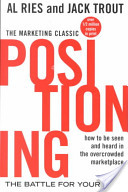All of marketing may be explained by clearly defining and using two words: Target and Position. Learn to use these two words correctly, and your business will prosper. Fail in either or both, lose focus in either, and your business will die.
Target: The single very narrow, focused customer type you really, really want to love your product/service.
TO BE CLEAR: I mean +/- 5 years of age, a clear gender, and ideally also some “qualifying” attribute. (example: M/25-35/Hardcore Gamers.)
Position: The unique place in the mind of your target you want your product/service to occupy.
TO BE CLEAR: I mean a clear position that you can own in the mind: “The Best”, “The Fastest”, “The Cheapest”, “The Healthiest”, “The Most X”, etc. (example: “The Most Hardcore Social Game Ever”)
So, how is this “all of marketing”?
Some example questions that come up in running a business should suffice to explain:
Question 1: Where should you sell your product?
Answer 1: Wherever the Target shops.
Question 2: What kind of copy should you write?
Answer 2: Whatever would please the Target while helping your product occupy a Position in their mind.
Question 3: How should you advertise?
Answer 3: Advertise wherever the Target is likely to see it; and ideally to solidify the Position in their mind, and eventually to drive buying behavior.
Question 4: Should I have a website?
Answer 4: If your Target uses the web… usually yes.
Question 5: What features should I have in my product?
Answer 5: Those features that help you occupy the Position in the mind of your Target.
Question 6: Should I partner with company X?
Answer 6: Only if company X is appealing to the Target, and can help you solidify your Position.
Question 7: What price should I charge?
Answer 7: A price that the Target is willing and able to pay, given your unique Position.
Question 8: Should I use Social Networks?
Answer 8: If your target uses Social Networks… usually yes.
Question 9: What if I have a new product?
Answer 9: Define it’s Target and Position… and STICK WITH IT.
Question 10: What if my product isn’t doing well?
Answer 10: Perhaps you need to improve the product for a better Position, or adjust the price to match your “actual” Position in the Target’s mind.
Question 11: Should I add feature X?
Answer 11: If the Target wants it.
I could go on and on… and you may say:
With such a narrow target, aren’t you losing out on sales?
Answer: NO!
You will get sales outside your narrow target, precisely BECAUSE you appeal so strongly to your target. (e.g. imagine all the people who “aspire” to be in your target.. or who themselves uniquely identify with your message/target). You don’t turn these sales away, nor do you let it change your focus… it is your appeal to your TARGET that lets you win other customers outside the target.
I hope this makes sense and helps! I am a bit passionate about this. Email me or comment with questions/feedback/ideas. I’m always open!


